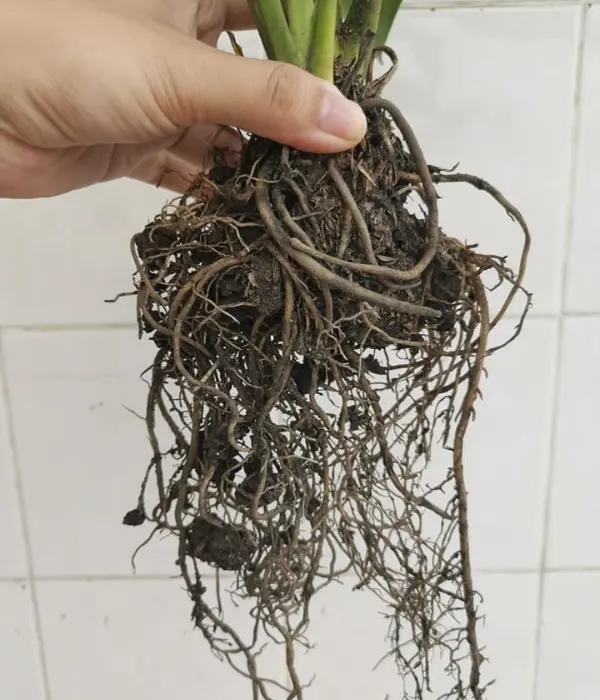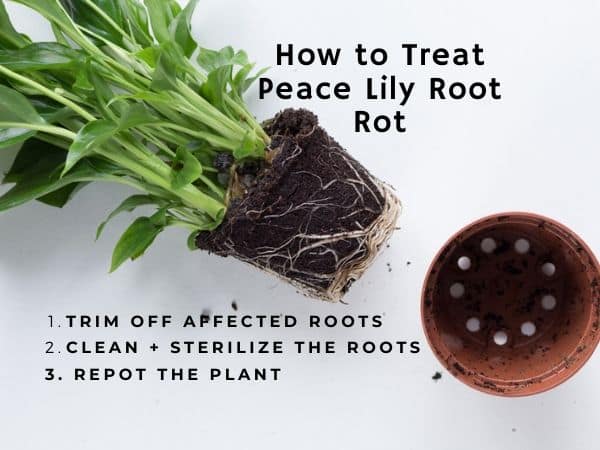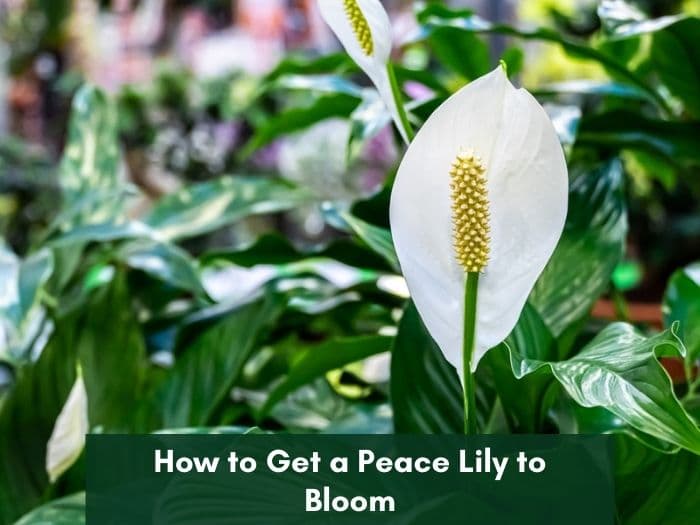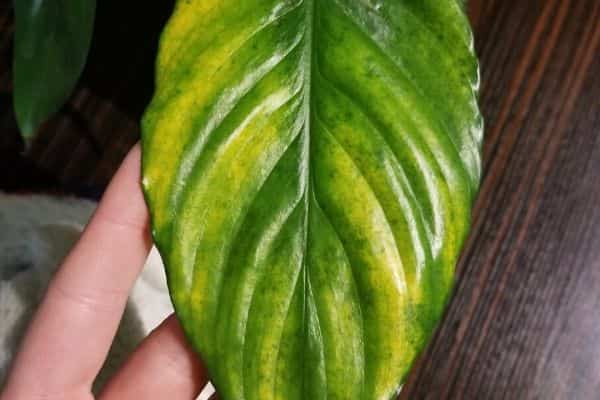How Do You Treat Peace Lily Root Rot?
Root rot is a fungal disease affecting the roots of a plant. Peace lilies (Spathiphyllum sp) are quite sensitive to watering and can develop root rot when overwatered. But how do you identify and treat the disease in peace lily plants?
The signs of root rot in peace lilies include drooping, yellow leaves, brown tips, and mushy, rotting roots. Remove the plant from its pot, cut off the unhealthy roots and treat the remaining ones with a 3% hydrogen peroxide solution. Repot the peace lily in a well-draining soil mix to save it.

Naturally, peace lilies grow and thrive in well-draining rainforest soil with sufficient nutrients from decayed matter. You want to try and mimic these conditions indoors for a healthy peace lily.
What causes root rot in peace lilies?
The peace lily plant is prone to root rot disease, especially when left sitting in too much water. As the name suggests, root rot disease is the decay of roots, which comes about when the plant grows in wet and damp soil.
There are two main causes of root rot disease:
- Overwatered, poorly draining soils: Waterlogged soil makes it impossible for your peace lily to absorb oxygen, leading to the death of some roots.
- The presence of fungus in the soil: Fungi are usually present in the soil but remain dormant only to thrive in wet and damp conditions. Such fungi become active in soggy soil.
Some of the fungi species that flourish in soggy soil include Fusarium, Pythium, Rhizoctonia, and Phytophthora.
When infected roots start to decay, the disease spreads to the healthier roots, and soon after, you’ll start seeing signs and symptoms on the plant’s foliage and general health.
Signs your peace lily has root rot
To determine if the plant has root rot, remove it from the pot and examine the roots as soon as you see some signs of disease.
Here are the signs that may point to root rot:
Weak and mushy roots
The first sign of root rot you’ll notice is that the roots will become weak, poorly developed, and mushy.
Remove the peace lily from the potting mix in order to examine the roots. Check for unusual color changes as well as integrity.
A plant suffering from root rot will have mushy roots that are evidently weakened. Some may fall off or peel when you hold them with your hand.
The affected roots may look like their normal color (black), just like healthy ones, but if you check closely, they will start to look as though they’re turning grey and frail.
Wilting and drooping
If the soil is moist, the plant is green, well-watered, and still appears wilted or droopy all the time, then this is the earliest sign of root rot caused by overwatering.
If your peace lily is droopy and the soil is dry, it is highly likely the problem is underwatering and not root rot. In this case, proper watering can revive the peace lily.
Yellowing leaves
If the plant gets indirect sunlight, then the yellowing and falling leaves could most likely be caused by root rot.
The foliage turns yellow because the plant’s roots cannot draw water, oxygen, and nutrients to support its life.
Stunted growth
If your peace lily cannot absorb the nutrients it needs due to root decay, then deficiency of the plant’s foliage becomes evident.
Slow growth in indoor plants happens when only a few healthy roots are functional.
Brown leaves
Brow leaf tips in peace lilies indicate overwatering and root decay. Check for waterlogging in the pot by dipping your index finger in the soil. If it comes out wet, the plant is sitting in too much water.
Only water the plant if the soil is dry, especially near the base of the roots. If the soil is wet, that is a sign of root rot disease.
You might want to drain the planter and even consider repotting to treat root rot.
How to treat peace lily root rot

There are three ways to treat a peace lily plant from root rot disease. One is to remove all the damaged roots, sterilize the remaining healthy roots, then replanting.
The second option is using hydrogen peroxide to water the base of the plant to kill the fungus.
The third one is repotting with fresh potting soil.
1. Repot the peace lily to treat root rot
I recommend treating the plant as soon s you see signs of root rot – when there are still healthy, firm, and white roots give it the best chance of surviving.
Here’s how to repot your peace lily and get rid of root rot:
- Remove the plant from the pot.
- Wash away the soil and the affected roots under running water.
- Trim the decaying roots using scissors or shears.
- Sterilize the scissors using an alcohol solution.
- Prune a third of the leaves to quicken the regrowth of roots as they will not have to support many leaves.
- Dispose of the soil in the plant’s pot.
- Wash the pot using a bleaching solution or 3% hydrogen peroxide.
- Dip the remaining healthy roots in a fungicide solution to kill off the remaining root rot fungus.
- Add a new potting mix in the planter and repot the peace lily.
Do not use fertilizers immediately after repotting to avoid stressing the already strained roots.
Also, ensure you always water the plant when the topsoil dries to the touch. This process will stop the spread of root rot and revive the dying peace lily.
2. Hydrogen peroxide treatment
Hydrogen peroxide kills unwanted fungi or bacteria. The extra oxygen molecule in hydrogen peroxide also boosts the growth of healthy roots.
Here’s how to use hydrogen peroxide to treat root rot:
- Mix one tablespoon hydrogen peroxide with one cup of water in a spray bottle.
- Spray the base of the peace lily with the solution and avoid wetting the leaves
- Allow the plant a few days to recover.
If covering a larger area with ornamental plants, hydrogen peroxide sprays will be more economical to use in a ratio of one part hydrogen peroxide to ten parts of water.
Can a peace lily plant recover from root rot?
Your peace lily plant is likely to recover from root rot if you identify the signs early enough. With proper treatment, such as cutting off the affected roots and treating with a fungicide, you’ll be able to revive the plant.
Prevention
Here’s what you can do to prevent root rot in peace lilies:
- Plant your peace lily in loamy, well-draining soil or potting mix rich in organic matter.
- In a garden, enrich the soil with decayed organic matter to facilitate adequate drainage.
- You can also use raised beds with well-draining soil.
- Use a mix of peat-based soil containing sand to retain moisture and nutrients without waterlogging the root zone.
- Ensure the peace lily’s pot has drainage holes at the base.
- Water the plant only when the soil dries out.
Conclusion
Proper care is key to preventing and treating root rot in peace lilies.
If your peace lily has root rot, trim off the affected roots and wash away all the soil from the roots. Wash the remaining roots and the pot using a weak hydrogen peroxide solution, and then repot the peace lily using a fresh potting mix. Water the plant lightly to avoid waterlogging.
More about peace lilies
- How to tell your peace lily is underwatered
- Why isn’t my peace lily blooming
- How to prune a peace lily
References
- University of Florida: Diseases of Spathiphyllum







